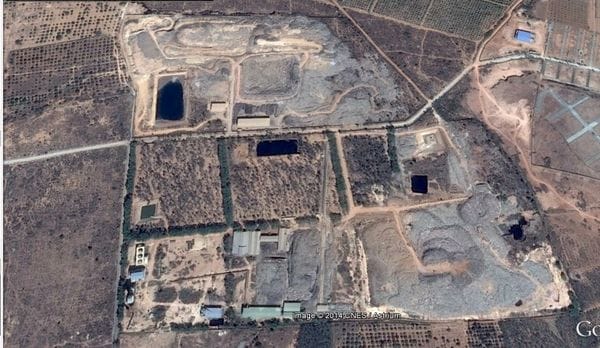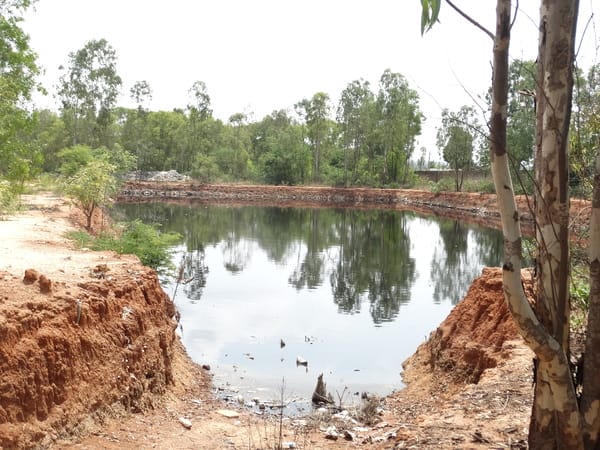A small portion of the garbage pile in Mandur landfill. Pic: Shree D N
The Bruhat Bengaluru Mahanagara Palike has withheld the payment of more than three crores to Srinivas Gayathri Resources Recovery Limited (SGRRL), the only processing unit at one of the garbage dumping yards at Mandur, that supposedly had the capacity to process 600 tonnes of waste per day. This resulted in the company shutting down its operations three months ago, claims Srinivas Reddy, the Operations Manager of the plant at Mandur, located near to Hoskote Highway on the north-eastern outskirts of Bengaluru.
BBMP hasn’t paid us the money for the past 11 months. That’s why we have stopped working for the last three months.
What BBMP says:
The firm has not done anything. The owner isn’t even seen in Bangalore. How can we pay such a firm? Money is ready, but they are not taking it and restarting the work.
Srinivas Reddy claims that every month, the plant owners spent Rs.15-20 lakhs on employees, machinery, watchmen and other resources but have not been paid by the BBMP for 11 months. However, he says BBMP continues to dump more than 1000 tonnes of waste in the land allocated for the firm.
When Citizen Matters visited the spot on June 6, 2014, the sheds constructed for “composting” the “segregated waste” were not operational. Mountains of unsegregated waste attracted vultures, dogs and other animals. A big pit dug on the ground contained leachate, to which the previous day’s rain added some water.
When Citizen Matters asked what happens to the leachate, the Operations Manager said it is pumped back on to the garbage piles. Some workers on site confirmed that this leachate was unsafe for human skin, as acids are produced while the mixed garbage pile rotted. There was no concrete or plastic lining in the leachate pit, so the leachate was free to seep into the ground – eventually joining the groundwater.
As per Srinivas Reddy, the plant doesn’t receive segregated waste. When asked how the plant was processing the mixed waste, Srinivas Reddy said there was an auto-segregation unit operational, which separated plastic from the wet waste. However, nothing was functional on the particular day.
It is not clear what the terms of agreement between BBMP and the firm were, but the permission for the plant was given at a time when there was no segregation at source mandated by the High Court in Bangalore.
A scene from the waste processing facility inside Madur landfill, belonging to Srinivas Gayathri Resource Recovery Limited. Pic: Shree D N
Srinivas Reddy evaded the questions on the agreement between BBMP and SGRRL, and refused to reveal the contact details of the owner of the firm. He asked us to talk to the BBMP instead. BBMP officials who visited the site refused to give up any details.
Srinivas Gayathri Resource Recovery Limited had got the permission for a biomass Waste To Energy plant – which means the garbage will be processed and part of it will be treated as biomass and will be fed into the power plant as fuel. However, there has been no action on this front from the firm, and the concerned were not open to speaking to Citizen Matters on the challenges they faced in the implementation.
BBMP rebutts the money claim
However. BBMP engineer in charge of Mandur landfill Munikrishnan says, “Money is ready. We have issued a notice to Srinivas Gayathri Resource Recovery Limited to take the money and start the work immediately. If they don’t, we will issue them termination order.”
The Karnataka State Pollution Control Board also issued a notice to this firm a few days ago, asking the reason for the pollution.
BBMP Commissioner Lakshminarayan blames the firm for not setting up a power plant. He says, “The owner has ran away from Bangalore. How do you expect us to pay Srinivas Gayathri Resources who doesn’t live in Bangalore and has failed to set up a power plant, as promised seven years ago? Not a single man is found on his site.”
The website of the firm is not functional. Srinivas Reddy confirmed that the Mandur landfill was the only place where the firm was operating. Srinivas Gayathri Resource Recovery Limited founder Ramesh Bhineri, whose address according to documents is in Basavanagudi, too evaded the questions, and said the plant is not functional as the BBMP hasn’t paid them for 11 months.
SGRRL got the approval to process Waste to Energy on October 14th, 2005 – the very year when the land at Mandur was chosen to dump city’s waste by KRIDL. However there was no plant set up until 2011 while the firm kept on saying the plant will be set up.
This is not the first time that SGRRL has been criticised. In 2012, when Rajneesh Goel was in charge of BBMP, he had also criticised the company for not fulfilling the tender conditions of landfill. Citizen Matters could not explore the reasons for delay in the process, as the persons authorised to speak to media were unreachable.

Google Earth view of Mandur landfill. While the upper (north) part has no processing firm, the lower part (south) has a firm Srinivas Gayathri Resource Recovery Limited which is dysfunctional.
Several notices issued, but no action
In October 2013, BBMP served a notice to the firm asking them to commission the plant by December 2013. Many deadlines have been passed. The firm continues to occupy the land but nothing has been done.
Mandur, a small village situated 15 km outside the city limits, has two landfills – Mandur North and South – measuring up to 135 acres. Organic Waste India Private Limited, a biomining and composting firm, has a pilot project operational in one part of the landfill, while the other part has SGRRL. It is not clear when the former started its operations, but the staff at the site claimed that it has a processing capacity of 200 tonnes while the latter’s capacity is 600 tonnes.
Thus, for the capacity of maximum 800 tonnes, BBMP can send maximum 100 trucks of garbage, but the quantity of waste taken to Mandur is much more. Apart from the new waste that is daily sent to the landfill, there are mountains of unaccounted unsegregated waste waiting to be attended. BBMP seems to be constantly trying to figure out how to deal with this, but there have been no solutions in sight yet.
Thus, this became the case of “taking more than what one can chew,” as some residents say. The problem was not so much before six years, but in the last six years, the village has been battling with many problems.
More tenders to be floated
BBMP seems to be aware of the ground realities at Mandur. To speed up the processing work, BBMP Commissioner Lakshminarayana wants to open tenders in a week for processing waste at Mandur. He says, “We are looking forward to processing waste units like the one at Kanahalli plant (a bio-methanisation plant that will process the city’s segregated restaurant waste only.) Based on the response for the tenders, we will decide how much capacity the plant should have. To add to it, 14 biomethanisation plants are soon coming up in the city.”
Back in Mandur, along with strong foul odour, the waste piled up for over a decade also generates huge amount of leachate. None of the firms at Mandur have the means to collect the leachate in systematic manner, though there are some pits here and there. Leachate, with previous night’s rain, had flown on to the road and made the entire road look dark in colour.
BBMP officials who had visited the spot say they want to tackle the issue by reducing the flow of waste coming to Mandur and divert the excess to other places. A compound wall will be built around the Organic Waste India Limited unit to prevent the leachate from flowing outside on to the road. This, again, is a short-term action, as there seems to be no formal solution to collect the toxic leachate inside the dump.

Leachate pit inside the Mandur landfill southern side. Pic: Shree D N
The workers at the landfill site warned us to stay away from the toxic leachate that can cause boils on the skin. They said it wasn’t safe to walk on it without proper protection for the feet.
Another BBMP official from Mahadevpura zone who is in charge of insect control at the site, said he brings workers from his area to spray insecticides and chemicals to control flies and mosquitoes. He proudly showed the flies which were struggling to breath their last. Everyday hundreds of litres of insecticide is sprayed on to the huge mountains of garbage and the new garbage that comes in.
Processing of mixed waste a challenge
Organic Waste India Limited works on the same principles as KCDC, using auto-segregation. It has two automatic segregating processing machines called shredders, of 100 mm and 50 mm.
Initially, the Organic Waste India employee at the site who refused to give us his name, claimed that they are getting only segregated waste. However, when we questioned him how the huge mound of plastic and mixed waste is lying inside the plant, he agreed that the waste they receive was entirely mixed. That includes plastic, iron materials, batteries, CFL bulbs and all types of hazardous and nonhazardous waste.
The auto-segregation technology this plant has is not able to separate everything entirely. In this system, the waste is pushed into a mechanised trommel where iron waste is attracted by magnets, while plastic and other waste is separated in the trommel by its size and by shredding. There appears to be no provision to separate toxic waste such as cells and bulbs.
When we asked what happens to plastic, he said, “Even we are trying to get rid of it.” Citizen Matters had reported earlier how plastic has been cause of worry for KCDC too. The actual plant of 1000 tonne capacity to be run by Organic Waste India Private Limited is supposed to come up at the site.
Villagers continue to protest
The villagers have threatened to stop the dumping lorries near K R Puram, as the government has imposed prohibitory order in and around 5 kms of the village by clamping section 144.


Its sad that after such a long period, still BBMP couldn’t search a new dumping place instead of Mandur landfill for which villagers were protesting due to mosquitoes, infective diseases, bad odour, they also have a right to live safely. They can’t be forced by BBMP as it is not solving the problem from the root having wasted so much time, either they instal treatment plants to produce manure / oil which could be utilised.If BBMP doesn’t have efficient and active officers or they shouldn’t enforce paucity of funds because it wastes its resources.
I am responsible for the entire filth of the nation!
Sounds arrogant? Try this like a public statement at home or at office
“I am responsible for the mess in my personal drawer at home and office.”
I need to invest and divert a few seconds in sorting instead of Gossip and small talk.